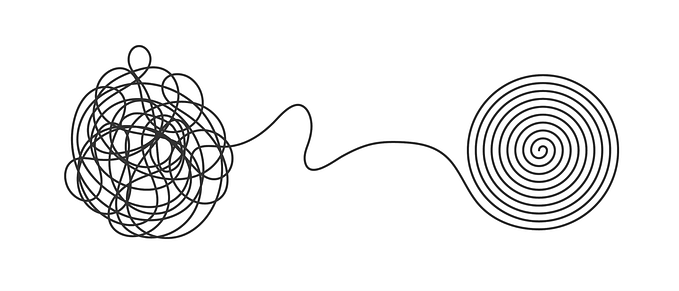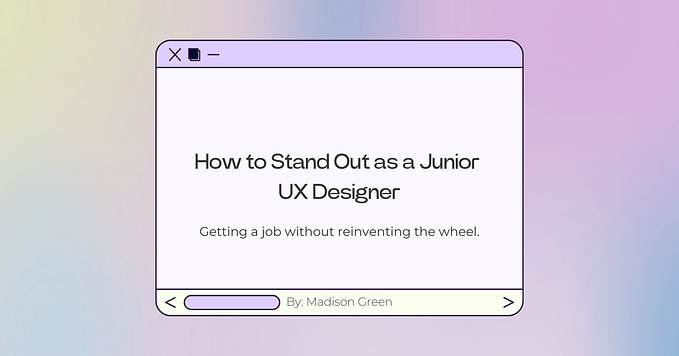How to get your first design job
When you don’t have 5+ years of experience

Q: I’ve graduated from school. At this moment I’m looking for a design job. Most companies are searching for experienced designers, but at the end I have to start somewhere. How do I start? – Marissa
This can be hard one. I remember being fresh out of school and feeling completely disheartened as I read job ads that asked for three, five or sometimes seven years of experience. When you’re new to the industry getting just one foot in the door somewhere can be tough — especially when companies require designers with years of experience.
So, as a new designer how can you score that experience and find your first design job?
1. Know what you want so you can prepare
Knowing what kind of design job or company you want to work for allows you to prepare and tailor your application accordingly.
As a fresh and wide-eyed designer, I initially thought design jobs were only available at agencies. Throughout my tertiary education design was taught in the context of working at advertising agencies or juggling with clients and polished briefs. I’d assume my life after school would be greeted with insane deadlines and endless client money to blow on projects.
I can’t tell you whether any of this is true. However what I do know is that the cadence of work at an agency differs hugely from in-house design.
Agencies tend to churn through projects. In comes one client project, out goes another, which creates an exciting and fast paced environment. Each project introduces you to a new set of stakeholders, brand guidelines and constraints. You may even be required to flex different design muscles each time. If working with different brands and getting your feet wet in marketing campaigns excites you, then agency life might be the way to go.
Alternatively, an in-house designer usually works on deeper, long-term problems within a specialised team. It’s likely you’ll be working with a product manager, researcher, copywriter, data scientist and of course engineers.
Unlike client projects, as an in-house designer there’s usually more room to explore, test and iterate on your ideas. Once a project is shipped it’s far from over. You’ll have the opportunity to improve it over time as you see how it performs.
In-house designers quickly become experts on the brand — this applies not just to brand designers, but many design disciplines. As a team you work on the same brand, audience, customers and mission. Soon you form deep understanding of the brand, which helps you to make decisions quickly and build better design solutions.
2. Find out what excites you
Design is so much more than branding or web design. While these are usually good starting places, there’s so much more to explore.
As a design student studying Visual Communication Design, my course covered everything from print to packaging to UX design. At the end it was really up to me which direction I wanted to go in. How do you make that decision?
Ask yourself — what is it that really excites me?
There must be a particular area within design in which you have a strong hunger to learn more about or tinker within. Perhaps it’s product design, communication design, motion design or even illustration.
Design comes in so many forms, shapes and sizes, that it’s worth considering which one you see yourself doing in the long run.
If you’re unsure — perhaps you want to do them all — think more about the kind of skills you want to learn over time:
- What techniques interest you?
- What are you interested in learning more about?
- Who are the kind of people you want your design to serve?
- What kind of problems or challenges are you interested in solving, through design?
A job is something you show up to every day, so it’s worth asking yourself what you can show up to every day with enthusiasm.
Remember, a job is not the finish line. A job is supposed to breathe and adapt as you do. Within a job should be opportunities for learning, growth and development. You don’t have to be an expert at 100% of the things on the job requirements list, but you should have an interest in becoming one.

3. Prepare your portfolio
It’s one thing to talk the talk, but it’s another to walk the walk. Hiring managers want to see your work — don’t be afraid by this! In fact, this is often the best part. It’s your opportunity to shine, stand out from the rest and embrace your individuality.
A strong portfolio shows passion within the work. If you’re preparing your portfolio for the first time, think back to your past work. What self-initiated projects, client work or school projects have you done that would make good case studies?
Make sure you have something relevant in your portfolio to the role or discipline you’re applying for, that you can talk about.
Consider including past projects that highlight your skills and show the type of work you want to be doing. For example, if you’re applying for a job as a web designer, it’s worth including strong web design projects in your portfolio. Perhaps leave out the screen printing project you did.
Remember there’s usually just as much interest (if not more) in the process and behind the scenes of a piece of work, than the final outcome. Throughout the interview it’s likely you’ll be asked questions about your past projects so they can learn how you work and what decisions you’ve made and why.
Portfolio pieces should communicate:
- The problem you’re solving and goals fo the project
- Your role in the project
- Ideas or wireframes that were used for testing and iteration
- Any research or studies used
- Assessment criteria
- Final solution and business results
A job is collaborative; you’ll very likely be working in a team. Highlight any times you’ve collaborated with others in your projects. How did they contribute to the design process? This helps to give a sense of how you work in a team and resolve conflict.
4. Stay on top of your game
Jobs rarely get handed out on silver platters. To score your first design job it’s worth keeping an eye on what’s happening within in your industry; news, people and jobs available.
Here’s a few things you can do:
- Network: Attend events in your local community and talk to people. When introducing yourself, casually mention that you’re looking for a new opportunity. They may be able to connect you with someone they know is hiring. If not, learn who the key players are and perhaps schedule a chat with them so you can learn more about the kind of work they do.
- Make a list: No, not Santa’s list, your dream jobs list! Keep a list of dream companies you’d like to work for, and seek opportunities there. If they’re not hiring right now keep them on your radar. What kind of work are they producing? Who works there? Check their jobs page frequently or find out who the design manager is. Keeping a keen interest in them over time will pay off in the future if you manage to score an interview.
- Find a mentor: This one is not so easy to do. Finding a mentor can be a challenge and often takes time and patience. The best mentors are found not by asking around, but by forming a connection with someone. Once yo’ve established a mentor, make sure to ask them for advice and guidance. Take time to meet with them regularly, learn from their mistakes and get feedback on your progress and applications.

5. Show initiative
It’s one thing to say you have a passion for design, but it’s another to show it. What can you do that puts you one step further than the rest? How you can you use your skills and passion to demonstrate your drive and initiative?
Consider what you’ve done in the past that shows you have a strong interest in the field. Any experience that shows you have initiative will be attractive to hiring managers.
Before you get hung up on the word ‘experience’, I challenge you to change your perception of what this means. Experience doesn’t necessarily mean ‘I spent three years working at a Fortune 500 company’.
Experience includes things like client work, self-initiated projects, school projects, volunteer work, workshops, certificates, online training etc etc.
What initiative have you taken that demonstrates that you have passion for design? Where are you going the extra mile?
Any extra initiative is already going to make you stand out from the rest.







